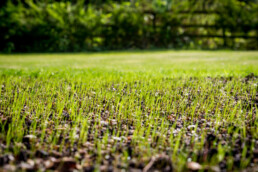When you think of gardening and landscaping, most people think of flowers, plants, trees, colors and scents. The lawn, on the other hand, often receives less attention, although it is usually the heart of the garden. It is sometimes taken for granted, but should by no means be ignored. If the lawn is discolored, gappy, full of weeds or very thin, no one is happy. A lawn has to look fresh and lush green. It is used for games, picnics and an afternoon nap; it is home to numerous insects, mice and other small animals. In short: the lawn is important for animals and people and has to be pleasing to the eye.
But one thing is not easy for many: How do I get the lawn to look dense, healthy and green? In the following, we present a few tips with which nothing can go wrong when laying the lawn.
How do I lay a lawn?
There are basically two options: Either turf is laid out, which is more expensive, but has an enormous effect in a very short time and the area can be walked on after about six weeks. Or lawn seeds are sown, which are significantly cheaper and less strenuous to sow. The disadvantage here, however, is that it takes significantly longer to achieve the desired result. It will take about three months for the lawn to be fully resilient and usable. When buying lawn seeds, it is important not to choose the cheapest product. It is best to ensure that the lawn seeds are a quality-tested seed mix (RSM). Usually, a higher purchase price is put into perspective, since fewer seeds have to be used because there is less failure.
Lawn seeding step by step
April / May is an ideal time to sow lawn, being careful with the temperatures of the past week. The seeds are hardy, but the soil temperature should not fall below 5 degrees Celsius.
1. Loosen the soil
The prerequisite for turf and seeds is that the ground is free of stones and weeds and the earth is loose and leveled. To achieve this, the soil must first be loosened. To do this, you use a spade or a digging fork for smaller areas, or you can borrow a tiller from a hardware store. The area should be loosened at least 20 cm deep so that the roots of the grasses have it easier later.
2. Prepare the soil
If the ground is loose, all stones (> 5cm), root remains and weeds that have come to light are collected. If couch grass or ground grass was previously on the area, you should take particular care to remove the plant with the entire root, otherwise you will not be happy later. This way, the lawn seeds can grow without the pressure of competition and you save a lot of future work. In the case of a new plant, the soil should always be improved. This should optimize the soil structure and activate soil life. Depending on the nature of the soil, different auxiliaries should be incorporated. Suitable for this are z. B. compost, peat waste, bark humus, wood fibers or special soil additives such as soil activator. In the case of strongly cohesive soils, the water permeability can be improved by incorporating sand. The soil is less susceptible to weeds and moss and the grasses can develop better on the loose soil. If you would like to know exactly, you can of course also have a soil sample examined by a soil research institute with regard to the required soil improvement, fertilization and suitable lawn mixture.
3. Create subgrade
Before planting the seeds, it is necessary to straighten the soil. A classic rake is ideal for this, and later also the rake. It is advisable here to create the subgrade with care. So there is no risk that the rainwater will later collect in depressions and wash away the seeds.
4. Fertilize the soil
To optimize the development of the lawn, you should apply a basic fertilizer to the area. There are special lawn fertilizers for this, which are worked into the top 2-3 cm of the soil with a rake. This minimizes the risk of damage to the seedlings, improves root formation and accelerates the initial development of a lawn. When it comes to the dosage, it is best to look at the manufacturer's instructions.
5. Roll the ground
In order to identify remaining dents and hills on the surface, the lawn subgrade should be lightly compacted with a roller. This can also be borrowed from the hardware store. If you still discover bumps after rolling, reach for the rake or rake again to remove them. Once the floor is level, it should rest for about a week. Then it is ready to be planted.

6. Distribute lawn seeds
Each manufacturer specifies exactly what amount of lawn seeds you need per square meter. If you don't know the exact size of your lawn, you can easily determine it with smart to plan. All you need is a smartphone or tablet with the measurement app. The area is measured in a few minutes and you can calculate the exact amount of lawn seeds. Fill the required amount of lawn seeds into a bucket or sowing tub and distribute the seeds crosswise over the area with a gentle swing. A tip: if you mix the seeds with a little sand, you can distribute them more evenly on the surface.
If you want to be on the safe side, you can also afford or rent a gritter. This automatically regulates the ejection of the lawn seeds and can also be used to fertilize the area.
7. Rake in lawn seeds
After sowing, the seeds must be hooked into the ground 0.5-1 cm lengthways and crossways. So the seeds have contact with the ground after rolling and they are protected from drying out.
8. Roll the lawn sowing
After sowing, it is rolled one last time in the transverse and longitudinal direction in order to create a so-called bottom seal. In the case of loamy soil, a 0.5 cm layer of turf soil can be added on top.
9. Water the lawn sowing
With a swivel sprinkler you can ensure that the entire area is watered. Here, too, it is worthwhile to be able to determine the exact size of the lawn, which you have already determined beforehand with smart to plan. If it doesn't rain in the following days, you should water the lawn around 4 times a day for around 5 to 10 minutes, as the seeds are still extremely sensitive to drought at the beginning.
And then?
The seeds germinate after about 1 to 3 weeks. In the meantime, be sure to water well. When you see the first green, you should extend the watering intervals and also increase the watering. When the grass is about 8 cm high, you can mow the area for the first time. After about 2 to 3 months, your lawn is finally fully resilient and you can look forward to it.
Would you like to find out more about how you can measure your garden with smart to plan? Check out or Features!
uncode-placeholder



